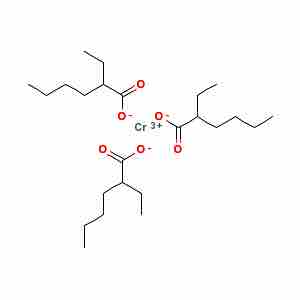Naming Transition Metals
Many transition metals exist as more than one type of cation. For example, iron exists as Fe2+ and Fe3+. Therefore, when you are naming an ionic compound containing iron, it is necessary to indicate which oxidation number the metal has. The oxidation number appears as a Roman numeral in parenthesis after the cation. For metals, the oxidation number is the same as the charge. Fe2+ in a compound with chloride would have a formula FeCl2 and would be named iron(II) chloride. The cation Fe3+ paired with oxygen would have the formula Fe2O3 and would have the name iron(III) oxide.
The procedure for naming ionic compounds containing polyatomic ions is the same as that for naming simple ions. Thus, CaCO3 is named calcium carbonate; (NH4)2HPO4, a compound with two polyatomic ions, is named ammonium hydrogen phosphate; and Pb2+ paired with SO42- (PbSO4) is named lead(II) sulfate.
Example 1: Write a correct chemical formula for each of the following ionic compounds: a. Aluminum oxide; b. Copper(II) chloride; c. Iron(III) oxide.
Solution 1: a. Aluminum is 3+, oxide is 2-; Al2O3. b. From the oxidation state that is given, copper is 2+, chloride is 1-; CuCl2. c. From the oxidation state, iron is 3+, oxide is 2-; Fe2O3.
Example 2: Write the proper chemical name for each of the following ionic compounds: a. Li2S; b. NiCl2; c. FeO.
Solution 2: a. We do not use multipliers, so this is simply lithium sulfide. b. We must specify that nickel is 2+ in this compound, so this is nickel(II) chloride. c. We must specify that iron is 2+ in this compound, so this is iron(II) oxide.
Naming Coordination Compounds
More complicated coordination compounds are composed of an atom or ion (usually a metal) and a surrounding array of bound molecules or anions, known as ligands. The atom within a ligand that is bonded to the central atom or ion is called the donor atom. A typical complex is bound to several donor atoms, which can be the same or different. Coordination refers to the coordinate covalent bonds (dipolar bonds) between the ligands and the central atom.
The set of rules for naming a coordination compound is:
- When naming a complex ion, the ligands are named before the metal ion.
- Write the names of the ligands in the following order: neutral, negative, positive. If there are multiple ligands of the same charge type, they are named in alphabetical order. (Numerical prefixes do not affect the order.)
- Multiple occurring monodentate ligands receive a prefix according to the number of occurrences: di-, tri-, tetra-, penta-, or hexa. Polydentate ligands (e.g., ethylenediamine, oxalate) receive bis-, tris-, tetrakis-, etc.
- Anions end in -ido. This replaces the final "e" when the anion ends with "-ate" (e.g, sulfate becomes sulfato) and replaces "-ide" (cyanide becomes cyanido).
- Neutral ligands are given their usual name, with some exceptions: NH3 becomes ammine; H2O becomes aqua or aquo; CO becomes carbonyl; NO becomes nitrosyl.
- Write the name of the central atom/ion. If the complex is an anion, the central atom's name will end in -ate, and its Latin name will be used if available (except for mercury).
- If the central atom's oxidation state needs to be specified (when it is one of several possible, or zero), write it as a Roman numeral (or 0) in parentheses.
- End with "cation" or "anion" as separate words (if applicable).

Example coordination compound
Chromium(III) 2-ethylhexanoate molecule.
Example:
Write a proper chemical name for each of the following coordination compounds:
a. [NiCl4]2−
b. Pt(NH3)2Cl4
c. [Pt(NH3)2Cl2]Cl2.
Solution:
a. Tetrachloridonickelate(II) ion. The complex ion, an anion, is inside the parentheses. We have to add the suffix -ate in the name of the metal.
b. Diamminetetrachloroplatinum(IV). This is a neutral molecule. The total charge on the ligands is -4. Therefore, the platinum oxidation number is +4.
c. Diamminedichloroplatinum(II) chloride. Here, the number of ions and atoms are the same. However, the brackets as well as the different oxidation number of the platinum result in a very different name.
The coordination number of ligands attached to more than one metal (bridging ligands) is indicated by a subscript to the Greek symbol μ placed before the ligand name. Thus the dimer of aluminum trichloride is described by Al2Cl4(μ2-Cl)2.